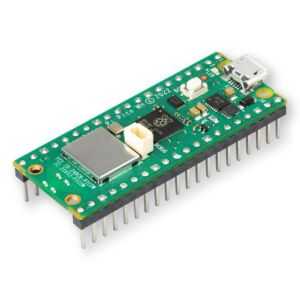Related Content
Transcript
Access the full workshop here: https://core-electronics.com.au/courses/raspberry-pi-pico-workshop/
You may know Raspberry Pi from their awesome line of single board computers, but the Raspberry Pi Pico here isn't a computer, it's a microcontroller board, which is a completely different game. A microcontroller still shares a lot of the same types of hardware as a normal computer, like a processor, a RAM, memory, it's got all of them.
So what's the difference between the two? Well, while a computer like your laptop or desktop is designed to perform a wide range of tasks, like browsing the internet, playing games, or writing reports, a microcontroller board like our Pico here is a tiny little processor that we can program to complete a very specific task.
And while a computer runs a fully-fledged operating system like Windows or Mac OS, microcontrollers typically don't have a user interface that you can interact with with a keyboard or mouse. Instead, they allow you to easily plug hardware into it, such as temperature sensors, light sensors, motors, servos.
Then you write some code, put it on the microcontroller, and it's this code that tells the microcontroller what to do with the hardware you have just plugged into it. For example, in this project, we plugged in a soil moisture sensor into a Pico, as well as a water pump. We wrote some code for the Pico, telling it to use the sensor to check how wet the soil is. In that code, we also told the Pico, if it's wet, don't do anything. If it's dry though, then turn on the water pump and water the plants. And the Pico just keeps looping that same task over and over and over.
Another example, this is an automatic garage door, and a Pico was plugged into it to allow the Pico to send signals to open and close the garage door. Some code was written to then use the Wi-Fi capabilities of the Pico to allow the garage door to be controlled wirelessly with a phone instead of that janky old remote.
A really cool example is the Mara Elephant Project in Kenya. They place a little microcontroller like this Pico here with GPS trackers and motion sensors attached to it onto elephants, and then they code it to wirelessly report the locations of those elephants. This allows researchers to gather data on and study the elephants, and for local rangers to track down the locations to help protect them from poachers.
Microcontrollers are also in everything. You'll find them in your washing machine, your computer mouse, microwaves, cameras, drones, electric toothbrushes. You'll find them in so many appliances it's not funny. They kind of act like a tiny little conductor inside of those devices controlling them, but they can only play the songs that they have been programmed to.
And a microcontroller is ideal for all of these applications over a normal computer because they use less power, they generate less heat, they're smaller in size, much, much cheaper, and because these applications need specific and simple tasks being repeated over and over and over, so a microcontroller is perfect.
And I think the most important thing to understand is that knowing how to use a microcontroller like this Pico here gives you the ability to build your own custom solutions to specific problems ranging from saving a species to simplifying and automating tasks around the house to designing and building your own product. And that's what we want to do. We want to equip you with a toolbox of skills to allow you to make awesome things, but it's all up to you how you use it.
Comments

Makers love reviews as much as you do, please follow this link to review the products you have purchased.








